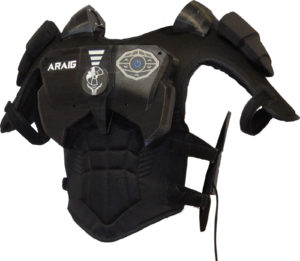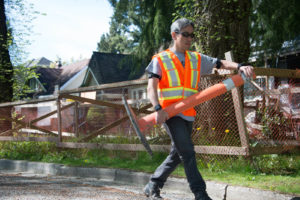
VR and AR industries offer high-tech solutions for demanding work environments
There was a time when “workwear” meant basically suits and coveralls, but the sector is now recognised as covering a broad field that stretches from spacesuits to medical workers. Providing protection, comfort and identification are standard, but it is challenging for the textile industry to meet the pace of change, for many types of workwear, in a timely and cost-effective way.
One solution is to look at what already exists in other sectors, taking a cross-disciplinary approach to technology, materials and know-how. One industry that is attracting attention from workwear designers is gaming, where research and development has a strong history, particularly in the development of virtual (VR) and augmented (AR) realities. Now seen as useful far beyond entertainment, and high-value, niche applications.
Games and the real thing
Much of the innovation in the VR and AR industries has traditionally come from startups driven by individuals that are usually motivated by their own personal interest in the technology. VR gloves, developed decades ago, were more visionary than ergonomic when they began to appear on the market in the late 1980s, early 1990’s. Mattel’s Powerglove for Nintendo games, for example, held its hard plastic controls on the back of the hand and wrist. It was not practical for repetitive movements over long hours of gaming, but it was an important step in the development of the industry.
One of the most successful examples of startup-initiated development in AR is Oculus Rift, founded by Palmer Luckey and launched with a Kickstarter campaign in 2012. This VR system is technically sophisticated, lightweight, ergonomic and—even in its first iteration—reasonably affordable. The Kickstarter fundraising campaign set a goal of raising $250,000 but emerged with almost $2.5 million, over nine thousand backers and the resulting publicity that money could not buy.
Today, many of the developments that had their beginnings in gaming are also looking to apply these technologies to high-tech workwear. IFTech is an Oshawa, Ont., Canada, startup that launched its first product, ARAIG, onto the public imagination with a dramatic Dragon’s Den pitch in March 2017 seeking CA$500,000 for a 20 percent stake. ARAIG, an abbreviation for “As Real As It Gets,” is a multi-sensory, multi-directional force feedback suit promising the wearer a complete immersive experience.
The company has identified three key market sectors – training/simulation, gaming/development and entertainment. Simulation is seen as key to training, particularly in the military, high-stress and extreme workplace scenarios. Wearable technologies such as ARAIG perform an important function in addressing both physical and psychological training.
The upper body garment is designed as an exoskeleton with built-in surround sound and localised sensory feedback that is coupled with a Stimulation shirt (StimS) next to the body to deliver highly directed sensations, such as impact, over the torso. Software development is in-house and allows for custom delivery according to the needs of the client.
Maritime navigation
Martha Grabowski is the Distinguished McDevitt Chair in Information Systems at Le Moyne College in Syracuse, N.Y. The focus of her research group is major maritime risk assessment that includes investigation into Wearable, Immersive Augmented Reality (WIAR) adoption in maritime navigation.
Grabowski asks what contributions might be made by WIAR technology to navigation decision-making and how this impacts safety in marine transportation.
In bringing together the wearable immersive environment with real-time data it allows for local knowledge to be introduced in a fast and effective manner. As weather, obstacle and other environment shifts can happen suddenly, this layering of data is of great benefit in averting disaster.
Grabowski takes the view that, “WIAR technology leverages networks, links and cloud capabilities inherent in virtual reality systems to provide local and transit-specific knowledge to the wearer for all piloting tasks”. A myriad of wearable devices contribute to this collection and dissemination of data. With the greater integration of technologies this process is set to become increasingly seamless and intuitive for the user.
Power vs. energy
In the mid 1990s Thad Starner, then at MIT, undertook research into human-powered wearable computing. He raised an important distinction between power and energy: “power, often confused with energy, is the time rate of doing work”. Energy is the capacity to do work. His motivation was the provision of power to allow for greater efficiencies in mobile computing, which was then in its infancy.
Starner envisioned that “power generation by body heat, breath, or motion can potentially power a computer.” Research is also under way to look at ways of lightening the battery load with soft exoskeletons providing one route to achieving this and providing benefit for those working in high stress environments, such as first responders and warfighters.
Reducing workplace injuries

LifeBooster Inc. has recognized the human and financial cost of workplace injuries and has introduced ErgoSenz to help alleviate this. The company, based in Vancouver, B.C., Canada, says that its goal is to eliminate preventable workplace injuries and keep the industrial athlete safe.
Additionally, the company says that musculoskeletal disorders account for an estimated 33 percent of these injuries, and are costing U.S. companies over $40 billion each year in claims and absenteeism.
ErgoSenz is comprised of a series of wearable wireless sensors linked to a cloud-based, risk analyzer that provides early indicators of musculoskeletal disorders. The system offers the possibility to recognize and analyze improper lifting techniques, as well as awkward postures, and repetitive motions from the entire workforce. Feedback and alerts are provided so that the workers, as well as health and safety professionals, can assess and mitigate risks in a timely manner and therefore avoid injury. The innovation looks to allow companies to take a proactive and preventative approach to possible injuries and so reduce the frequency and severity of expensive accidents and injuries.
Protection in workwear has long been a given, but developments in VR and AR, particularly, are allowing for greater efficiencies in preventative care with knowledge from many disciplines now being brought together to allow for more informed products in the sector.
Marie O’Mahony is an industry consultant, author and academic. She the author of several books on advanced and smart textiles published by Thames and Hudson and Visiting Professor at the Royal College of Art (RCA), London.
 TEXTILES.ORG
TEXTILES.ORG


